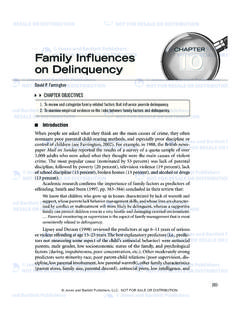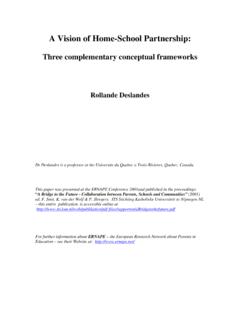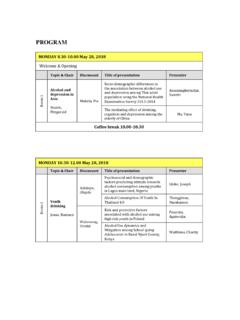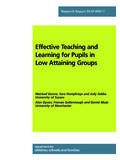Transcription of Positive Touch and massage in the neonatal unit: a …
1 Positive Touch and massage in the neonatal unit : a british approach Cherry Bond Winnicott Baby unit , St Mary's NHS Trust, London , UK Semin Neonatol 2002; 7: 477-486 There is now a general trend towards a more baby friendly, family centred approach in the neonatal unit . Aspects of that approach - including Positive Touch and massage - are gaining in popularity. This has caused much debate due to the ambiguity surrounding the implementation and validity of the interventions, Here the impact of these complementary practices (not to be confused with complementary therapies) is discussed A review of the author's approach and potential guidelines for implementation is provided. Key words: Positive Touch , massage , family, developmental care, preterm, infant, facilitation, NICU Introduction Staff working in neonatal Intensive Care Units are increasingly looking for new ways to help newborn infants and their parents to endure the stressful experience of the modern day neonatal Intensive Care unit (NICU).
2 Neonates not only deserve to receive the best biomedical-technological care, but also the best possible humane, psychological, and emotional support [1]. One way of helping to achieve this is with the use of a Positive Touch (PT) approach . What is Positive Touch Positive Touch involves various types of infant Touch -interaction including handling, holding, kangaroo care and massage . Positive Touch is a term coined by the author and developed from her original booklet A Silent Dialogue, which was purely based on massage . The technique originated from Dr Frederick Leboyer's book Loving Hands which illustrates Shantala, a young Indian mother, massaging her baby in the streets of Calcutta [2]. Following qualification with 'The International Association of Infant massage ', and an introduction to a NIDCAP based programme, the approach was modified and re-named Positive Touch .
3 This term reflects the adapted style that is now linked to a family centred developmentally sensitive philosophy so that it can be utilized for the smallest of infants in the NICU. The goal of PT is: To gently guide parents to some sense of mastery and ownership of their infant [3], in a difficult atmosphere of uncertain circumstances [4]. To facilitate parental attunement to the behaviour of their infant, with the intention that because the brain develops in sequence, with more primitive structures stabilizing their connections first, early infant interaction is potentially beneficial to future development [5]. To enhance the immature infant's experience. In the harsh NICU environment [61, avoiding prolonged stress, tactile aversion/avoidance and acute distress could have long-term health and behavioural benefits [7]. To generally improve developmental outcomes on the premise of enhanced social, environmental and socio-environmental factors, which are known to be important predictors of good developmental and behavioural outcomes in preterm infants [8].]
4 The baby's experience The skin is the largest sensory organ of the body (about 2500 square centimetres in the newborn), and the tactile system is the earliest sensory system to become functional, the medium by which the infant's external world is perceived (9]. In premature birth the infant is called upon to make many adaptive responses to its new environment and, instead of building on the threads of sensory familiarity of Touch , taste, smell and sound known in prenatal life, the transition to extrauterine life is a jarring disruption and a relentless introduction to a clinical world [101. Steven Hoath describes the skin as 'smart-material, which is a flexible and adaptive interface'. The preterm infant skin subserves multiple roles including: (1) a sensory surface for the infant; (2) a protective mantle; (3) a psychological/perceptual interface with caregivers and parents; and (4) an information rich surface for non-invasive monitoring [I I].)
5 The possible effect of giving an infant comforting skin messages is therefore evident on many levels [121. Only a few decades ago it was believed that young children loved their parents simply because they provided nutrition, shelter and warmth, There was no evidence then, unlike now, that the brain contained emotional systems to directly mediate social bonds and social feelings [13]. This early behaviourist view began to change when it was shown that babies failed to thrive if they did not also receive both physical as well as emotional affection. The classic studies of Rene Spitz in the 1940s [141 demonstrated that babies in orphanages who did not have caring human contact often died prematurely. This lesson is being learned once more in Romania and former eastern block countries where infants from orphanages suffering from Touch deprivation, achieve only half the normal height for their age.]]
6 The PT approach provides a caring sensory dialogue taking into account the sensitivity of premature skin and the consequence of Touch on a fragile neonate, even when he is too unstable to be held. It gives the infant a sense of a comforting holding environment by a consistent caregiver (usually the parent). Who should do it? It is primarily practised by the parents who are the most appropriate givers of loving Touch as they are the most consistent observers of their infant and have the essential emotional investment needed to give loving care. Consistent care giving is a goal that is rarely achieved in the neonatal nursery, yet it is a requirement and a probability for most newborn infants. Bender's work highlights the lack of constancy of all sensory experiences, including Touch ; he has looked at the innumerable caregiver's styles of handling, suggesting this may delay the baby's capacity to build up a consistent picture of his or her environment [15].
7 When would you do it? Positive Touch is a way of counterbalancing the many and sometimes inevitable, unpleasant experiences, which seem to be a result of highly technical neonatal care. The approach works best if incorporated into the standard accepted care of the neonate. It would be as appropriate to give containment holding when performing a clinical procedure, such as insertion of an intravenous line, as when an infant is simply crying alone in the crib/incubator. In contrast, especially arousing types of Touch such as massage could be done at a specific time when the baby indicates they are ready and the parent is present. Implementing Positive Touch The dialogue of Touch is like any language: one needs to be able to listen and respond, and to both give and be receptive. Positive Touch is always done 'with, not done 'to' a baby. The baby's responses/cues are pointed out in a way that shows that the baby is doing the teaching.
8 Step 1. Preparation and observation When working sensitively with parents and infants at a time when they are both in a distressed state, it is necessary to just be with them without an agenda. This period offers an opportunity to simply listen with no preconceived ideas or judgement. Creating a space for parents to express emotions and fears can relieve some of their own burdens. This, in due course, frees them to think more about, and 'see' their baby [16]. Parents (and other caregivers) can find it difficult to identify with the preterm infant, as their cues are masked in the subtle veil of prematurity [17,181. Pointing out individual infant cues/reactions that signal engagement, disengagement, and selfregulatory abilities, can guide the parent towards appropriate, safe Touch for their baby at any given time. This interactive 'language' can be learnt and used in any situation so that care is always safely adapted to the individual infant's tolerance levels [19].]
9 Parents who become experienced with this 'dialogue' can then be continually aware of their baby's amazing capabilities, and move forward in understanding the developmental possibilities, strengths and vulnerabilities of their baby, so that a whole picture of their unique child emerges rather than merely his medical condition. Step 2. Parents in attendance, without Touch Extremely premature infants, those who are recovering from surgery, or infants who are very sick and/or sedated, may not tolerate even the slightest of touches. In this situation, parents can be encouraged to sit by the bedside and quietly make their presence fell by leaning close and putting their hand(s) a few centimetres away from their baby's head or/and feet. Facilitating the parents to take slower, deeper breaths themselves can help ease tensions. If they are able to; picturing a soothing colour that surrounds the infant can also help relax the parent, which in turn can have a soothing impact on the baby.
10 Although there is no direct contact, the parents can experience a connection with their infant, which can provide an optimum opportunity for involvement at a time of great stress and uncertain survival [20]. The nature of a neonatal loss is often sudden and unexpected; it is vital to encourage some kind of contact during these early bedside encounters. It demonstrates from the outset that we always value the baby as being part of a family. Step 3. Initiating Touch (permission) Ideally every Touch we give should begin by preparing the baby with a thought or a word of intention of the impending approach (we infant massage instructors call this 'permission'). The decision to initiate Touch , or not, is judged by taking note of the baby's behavioural state, medical condition, and watching for signals of acceptance. This crucial step demonstrates that we respect the baby's ability to be participants in their own caregiving.







